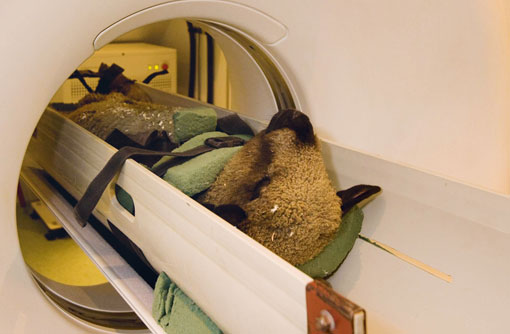CT scanning terminal sires key to profitable sheep production

Commercial prime lamb producers should seek out breeders of terminal sires who use CT scanning to optimise the accuracy of their trait selection. That’s according to the SAC’s leading geneticist, Lutz Bunger, who says these sires hold the key to the future of profitable sheep production.
CT scanning is now widely used across terminal sire breeds. And more rams are available for commercial use whose performance data and trait heritability are based on the high levels of accuracy it produces. Dr Bunger says it presents a great opportunity for commercial producers to achieve guaranteed improved performance from their prime lambs.
Figures from Signet show that EBV accuracy values in CT scanned sires are significant, particularly when looking at specific traits such as gigot muscularity where CT scanned sires have an average accuracy figure of 82% compared with non-CT scanned sires, which have an accuracy value of just 68%.
Breeding for that extra chop
But Dr Bunger is also looking for new traits which can be included in terminal sire selection. “We’re now looking for variation in the number of vertebrae in terminal sire breeds. This could lead to prime lambs being produced with an “extra chop” if there is a genetic basis for this trait.
“Ultrasound scanning only gives 50-60% accuracy, so if you want to increase lean and decrease fatness – and are relying on ultrasound scanning – you are only achieving around half the accuracy level. With CT scanning it’s potentially 100% accurate.”
Dr Bunger believes that because of the extent of CT scanning under way, commercial prime lamb producers now have an ideal opportunity to select rams whose breeding is benefitting from the accuracy it affords in each generation.
“But the breed societies really do need to get to grips with this by rewarding members who are using CT scanning for the good of their flocks, the good of the breed and for the benefit of commercial sheep farmers,” says Dr Bunger.
He believes current figures, which show that 71% of slaughter lambs are produced by a terminal sire breed and bred out of Mule ewes, highlight the potential to capitalise on CT scanning.
“It’s no secret which breeders are involved in CT scanning. It’s up to sheep farmers to find out who they are and where they can procure these superior genetics. They will provide guaranteed success in terms of trait heritability. CT scanning will produce traits for killing out percentage, meat percentage and reduced fatness.”
But in the future Dr Bunger believes there’s a need to identify 3D muscularity scoring so that when a loin is scanned the image is not simply a cross-section but provides data on the whole muscle in relation to the bone that lies underneath.
“This will differentiate between sheep with a thick, compact loin and those with a thinner, more stretchy loin. A similar 3D assessment will be made on the hind legs and also on the vertebrae to count vertebra numbers.”
“Ultrasound scanning only gives 50-60% accuracy, so if you want to increase lean and decrease fatness – and are relying on ultrasound scanning – you are only achieving around half the accuracy level. With CT scanning it’s potentially 100% accurate.”
Lutz Bunger
Improving taste and minimising waste
Dr Bunger says his aim is to “reduce waste and increase taste” – something he believes can be achieved using the information produced by CT scanning.
“We want to increase killing out percentage but also maintain the taste of the meat. New research has shown that the density of a muscle that can be measured using a CT scanner correlates with the intra-muscular fat, so the less dense muscle has more intra-muscular fat which is equivalent to marbling in beef.
“In sheepmeat you can’t see it with the naked eye, but the CT scanner can identify it – and this is essentially what makes the taste.
“We must avoid at all costs what happened to pigs where animals became too lean and the pork lost some of its taste. We need to learn from this and by using the CT scanner we can measure the amount of intra-muscular fat – which influences taste – as well as the carcass fat.”
A total of 87 flocks in the British Texel Sheep Society were CT scanned last year. And since CT scanning became more readily available more than 2,700 Texel ram lambs have been scanned, according to Texel Breed Society chief executive John Yates.
Pedigree Charollais breeder Charles Sercombe runs a 200-ewe flock at Melton Mowbray and has been CT scanning for 10 years. “You can have two or three rams that produce similar results from ultrasound scanning, but when you put them through the CT scanner it throws up the high flyer – and that’s what we’ve got to aim for as breeders.
“And rams with the superior CT results are consistently producing progeny of equal superiority so this is proving to be a very valuable breeding tool for the sheep industry,” says Mr Sercombe.
Livestock 2012
For more news and information on Livestock 2012 see our dedicated page
